
pioneer
-
Posts
18 -
Joined
-
Last visited
Content Type
Profiles
Forums
Events
Gallery
Blogs
Posts posted by pioneer
-
-
So yesterday I fitted a Sterling Pro-Reg B and 4x SBS40 Batteries to my 90 and I thought id share for anyone else who might be interested in doing something similar.
1st Things first, Remove alternator
Now that I have installed the regulator I have found out that this step is no necessary as you can remove the alternator regulator without taking out the alternator lol. Removing the alternator on a 300tdi is not to much bother tho

Pieeater3142 in the background playing with his inter cooler pipes
Now to connect a new field control wire to the brush's
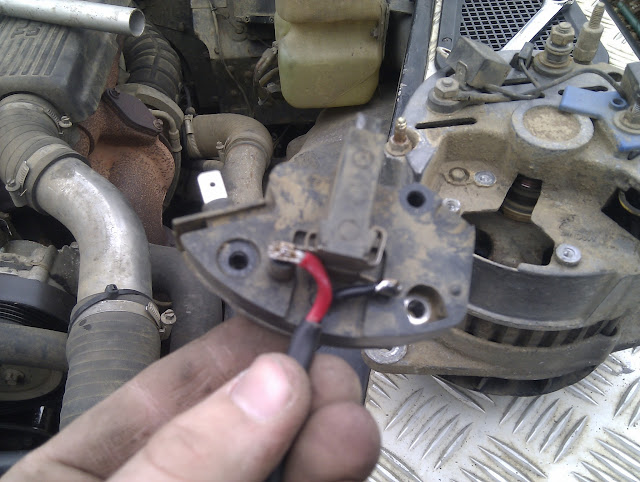
The instructions say to fit wires two short wires to the brushes, this is so that once the alternator is re-assembled we can measure the voltage from each wire two ground to work out what wire is the field control wire.
For anyone else fitting the regulator to a 300tdi (not sure on alternator type on 200tdi) you only need to connect a wire to the brush I have connected a black wire to as this was the wire that controls the field
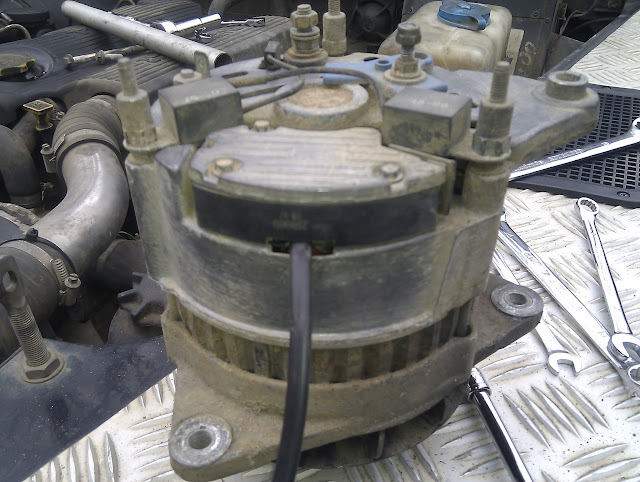
Now to fit the regulator
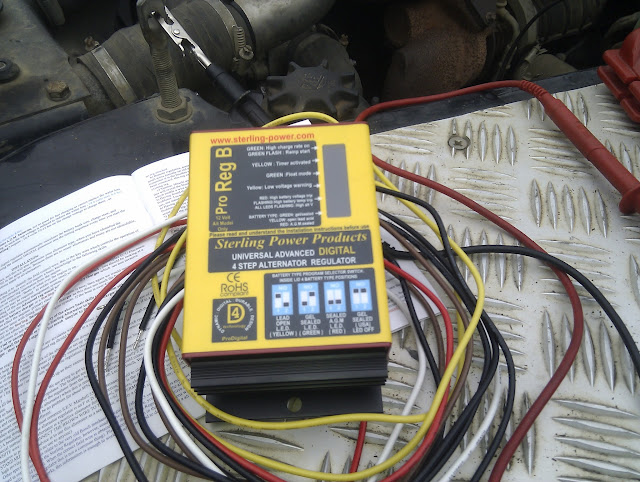
Before fitting, remove the case and set the battery type. You can chose between Conventional Lead Acid, Sealed LEad Acide / AGM, Gel Batteries (Exide spec) and Gel USA Setting.
As I am installing it with some SBS40's I have set mine to Sealed Lead Acid
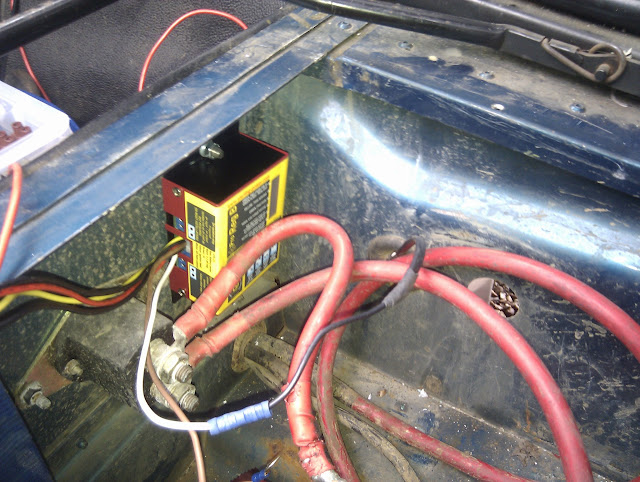
After looking at tide marks etc in the battery I find that the front edge of the box is the driest.
The regulator need's 4 wires running back to the alternator
The new field controll wire (white), D+ wire (brown) and 2x Negative (black) to the case of the alternator, these need to be septate wires back to the alternator not joined together
You also need to run an ACC wire to the regulator to switch it on with the engine.
The last wire is the voltage sense wire, this just connects to the positive terminal on the batteries.
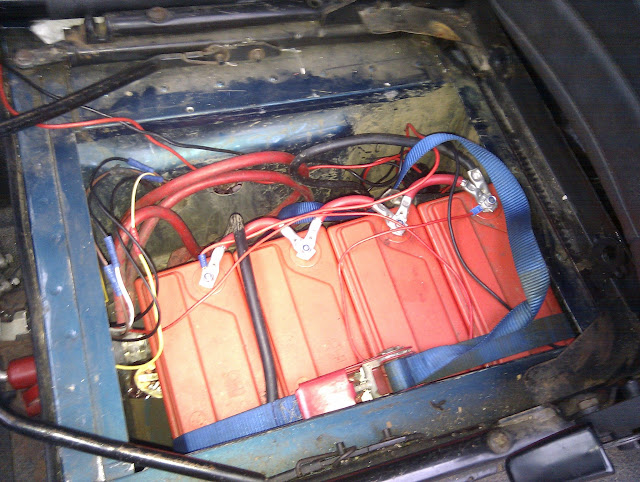
All installed, Land rover cranks over no problems and now the alternator is kicking out 14.4v while running

The 4x SBS40's might seem to be an overkill but they where free so I thought I might as well use them.
Quick spec on the battery shows that they are 500cca / 2000a Short Circuit amps, 38Ah
This now gives me a a hefty 2000cca and 152ah of capacity

They also have an operating temperature of -40 to +50deg c so should be good for cold winter mornings (getting warmer now so that should not be an issue)
-
If you're traveling alone or with one other person, a 90 should be big enough to overland in.
this is true, but I also regularly give lifts to people and this ties up the back of the 90, least with a 110 CSW i can have the seats clear and kit out the back

Also the extra load space would be handy if needed, suppose I could always get a NATO hitch and go for a wolf trailer conversion
-
Don't forget 110 back axle, if you want it to be legal. A 110 rear prop wouldn't reach a 90 axle on the back of a 110.
I'm sure very shortly the argument will start about which of the various ways of skinning the DVLA/VOSA/SVA/IVA/VIC cat you'll need to do, I suspect the answer is that even the DVLA/VOSA won't really know what's right / least hassle and if you phoned them 5 times you'd get 5 different answers.
The least hassle option would be to buy a slightly ropey 110 - that gets you the tub, roof, back axle, props, and perhaps most importantly the V5. If you re-chassis it with a galv one at a later date, replace the crusty bulkhead, knacered engine & box, etc. is then a matter of rolling repairs to the 110 as per most LR's which are a few years old.
However, you have then taken your perfectly good 90 apart (or "Done a Will Warne" as it's known
 ) rendering it a fairly low-value rolling chassis, so you need to weigh up whether ultimately you should just sell the 90 as a complete 90 for good money and put it towards a good 110 and save a hell of a lot of farting about.
) rendering it a fairly low-value rolling chassis, so you need to weigh up whether ultimately you should just sell the 90 as a complete 90 for good money and put it towards a good 110 and save a hell of a lot of farting about.90's being popular for off-roading you may even find someone willing to PX you a 110 for your 90.
Ahh,
My mate has just informed me about Q plates as well :-s More hunting for 110's then is probably the best bet.
Didn't know about the difference in rear axles, maybe I should just tart up my 90 as its kitted for off road (winch, protection, lift)
Really I need the space with the option of overlanding later on

Thanks for the advice
-
Thanks for the fast replys, I will have a look about and see about removing the half shaft seal (not the hub seal
 )
) -
I really want a 110, but my 90 has just had its gearbox rebuilt and the engine runs well and the bulkhead is in v good condition.
Looking on eblag etc for 110's seems to be a bit hit and miss, so now my current trail of thought is to get a 110 galvanized chassis and swap + add parts from my 90 then sell the bit I don't need (90 has a galvanized chassis)
From what I have worked out and seen from bulkhead and dash forward are the same so I will really just need to get a 110 tub and rear sections + new prop-shafts.
What do you think, good project? Has anyone here done this before? or should i just carry on looking for 110's
Regards, Tom
-
 Aren't all axles sealed and oil filled??
Aren't all axles sealed and oil filled??Do you mean that a seal was taken out so that the wheel bearings run in oil not grease?
Yea axles all ready have oil in them, there not fully sealed though as they have breathers at the top, this one the bearings ran on oil as well. I think they where custom hubs, not sure tho.
-
Hi,
Ages ago I saw a defender for sale that had sealed oil filled axles.. I cant for the life of me remember who made them or find the advert for the defender though

Does anyone have any experience with these or know a company that makes them? I think it was basically new hubs on the old axle.
Regards, Tom
-
-
Lets try that again

12v---+------------+ | | RESISTOR | | | |------GUAGE-+ | TEMP SENSOR | 0v----+ -
Not shown on this pic:

Guess there not needed then..
-
Email sent
-
Also whilst I have the bodywork off the car - does anyone know where I can tap into the diesel line for the eberspacher heater? Can I go in after the fuel lift pump? Should I use the return? Or do I need to tap in before the engine does anything with it?
From having a Google about the place people are suggesting is after the lift pump and before the filter.
I was thinking of fitting mine after the filter as it would save adding a separate filter in-line but I am unsure as to how will the Eberspacher's fuel pump will work with the extra resistance.
-
Does anyone know how the temperature sensor work's on vehicles?
The way I think they work is as a voltage divider as one side is grounded to chassis and the other goes to the dial.
Something like this
12v---+------------+
| |
RESISTOR |
| |
|------GUAGE-+
|
TEMP SENSOR
|
0v----+
Tom
-
not sure on a 110 but on my 90 from what i can remember they dont do anything except having something cabletied to it
James, look under your 90. on mine i have something similar that is supporting the cross bar/support on the tub (if that's what it is called)
-
Mine engages with a 2 way air ram


G
Lovely engineering, Where do you get the air from? compressor in the air con spot or electric?
-
I don't have a large garage, which is incidentally now full of all the body panels, seat box, bonnet etc. so I have borrowed a party tent and it is now taking over the drive.

And what a fun evening that was, Good job I have a pair of Hella worlk lights on my 90

When are you going to put some photo's up?
-
Not quite true, there is no reason why you cannot either extend your coolant system or run a separate coolant system.
We run a D5W to power 2 household radiators in our coach as a separate coolant system (OK, in a Land Rover that might be harder to do due to space)
I have got a D5W for my Defender(yet to fit) I don't think it will cause to much of an issue if I add another heater matrix into the cooling loop (paralleled with the original one)


Immobilising a 200tdi Defender - insurance thoughts
in Defender Forum (1983 - 2016)
Posted
My landrover is 10% Scotch lock's, think the rest is unspecified wires, electrical tape and cable ties